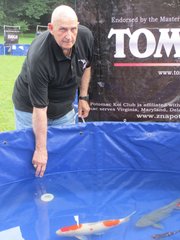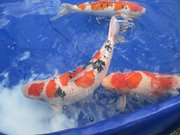If these fish look like an Impressionist painting, it is because they are considered by hobbyists as living works of art. Photo by Donna Manz.
If Meadowlark Botanical Gardens and glistening other-worldly koi seem to be a perfect fit, that’s because they were harmoniously wed on Sept. 7 and 8, as the ZNA Potomac Koi Club presented its annual koi show and competition. The competition, bringing in nishikigoi [koi] hobbyists from Connecticut to South Carolina, was open and free to the public. Two hundred and sixty two nishikigoi, “living jewels,” entered the competition this year, breaking the Potomac chapter’s record for the show.
“I keep koi for their beauty, for calming viewing. They are living flowers,” said Glenn Crispell of Vienna. Crispell’s koi won several awards, including “baby” Grand Champion and first-places. Crispell said that when he comes home from work, he goes outside to the 5,000-gallon koi pond to make sure everything there is “all right.” He checks the filters, the waterfall, the ozone injectors. Then, he feeds his koi. “When they see me coming, boy, do they run to me. Like a torpedo going through water.
ZNA—which stands for Zen Nippon Airinkai—is an international association of koi clubs. The group started in Japan in 1968, and, even today, judging standards are defined by the governing body in Japan. Six judges, including two from Japan who paid their own transportation to Washington Dulles, judged the competition sponsored by the Potomac chapter.
At the weekend show, vendors sold koi food, koi-keeping equipment including massive filters, Japanese maple saplings and koi themselves. Vienna Aquarium, now located in Leesburg, sells koi to hobbyists from north to south and was a busy booth throughout the show.
Start-up cost to raise a koi is not cheap. Owners need the pool or pond, filters, food and other accoutrements of the hobby. Many owners include rocks that can cost several thousand dollars and create multiple waterfalls.
Typically, koi go dormant when the temperature falls below 55 degrees. They don’t eat while they are dormant, which, in Virginia, is usually a six-month hiatus.
Nishikigoi, the ornamental cousin of carp, first appeared as mutations in the early 19th century. These mutated carp were bred to perpetuate the distinctive characteristics of each variety, of which now there are more than 100 varieties, divided into 16 groups by ZNA.
Zen Nippon Airinkai promotes nishikigoi-keeping as an artistic expression and its board sets the judging standards. The Japanese ambassador to the U.S. has a koi pond at the ambassador’s residence.
“It’s a hobby, it’s beautiful,” said Bernie Grace, a Vienna koi-keeper who loves landscaping projects. He built the koi pond himself. “We have a waterfall and we sit around and enjoy the sounds of the water and looking at the fish. It’s just a lot of fun.”
To learn more about the Potomac chapter of ZNA or to join, go to http://www.znapotomac.org/. At http://zna.jp/eng/, you can learn quite a bit about nishikigoi, the many varieties and the structure of the club.



